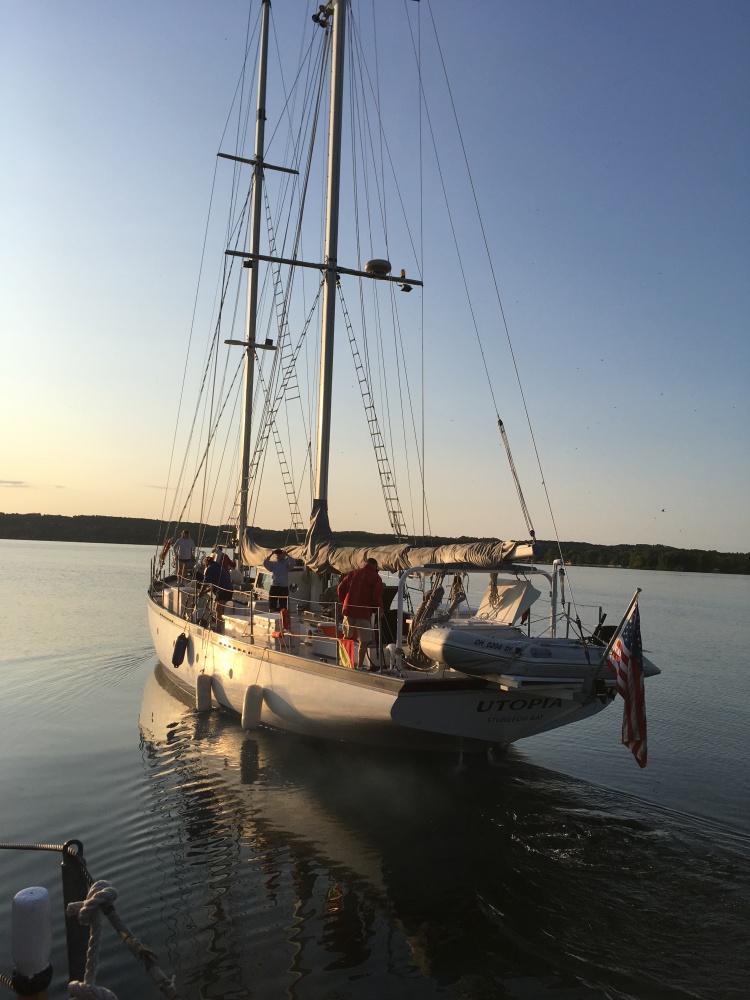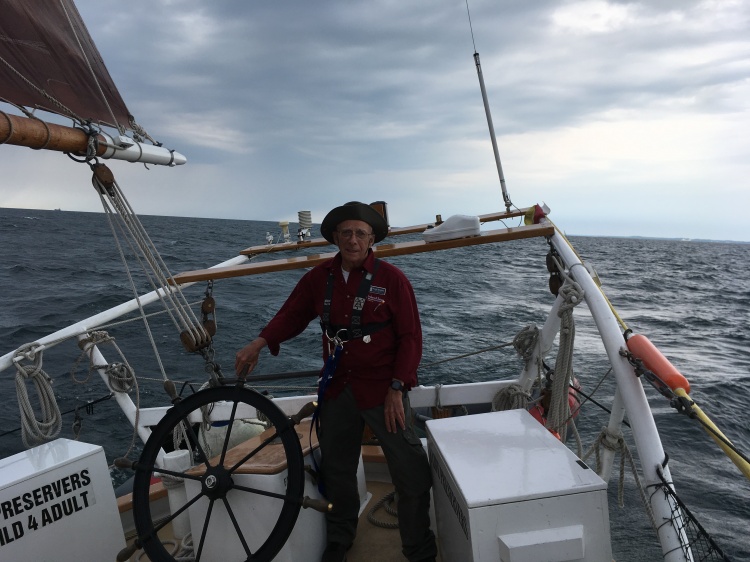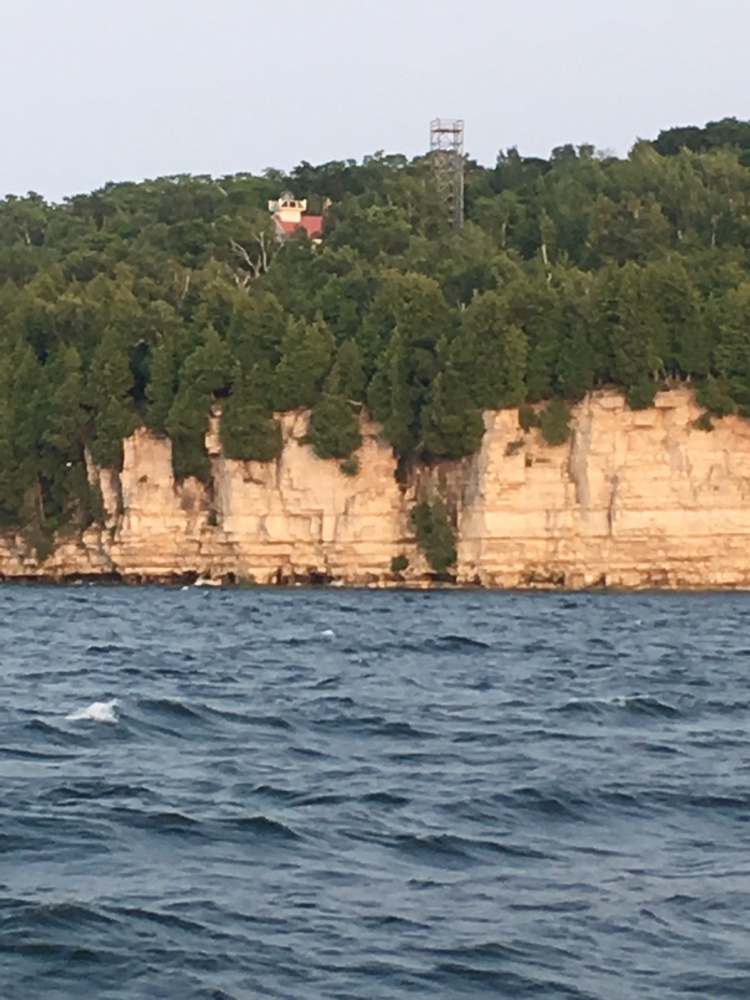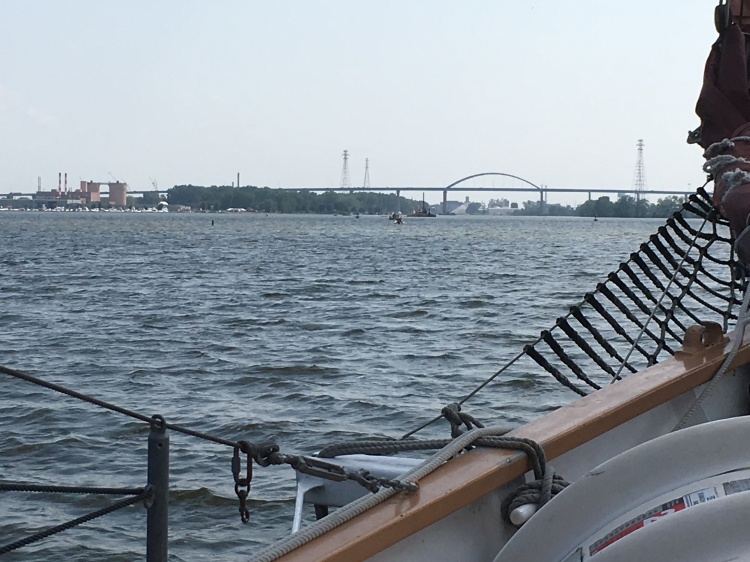This blog was written by Frank Simkins about his experience sailing across Lake Michigan aboard the schooner Inland Seas in 2019. Frank is a volunteer with ISEA and shares a profound passion for the Great Lakes with students, crew, and staff alike. If you would like to write a blog post please contact marketing@schoolship.org.
Departure
When I arrive in Suttons Bay at 7:15 am on July 24, 2019, I find the crew already preparing the two boats for a planned 8:00 am departure. The Inland Seas and the Utopia will be making the two day trip together to Green Bay Wisconsin for the 2019 Tall Ships of America Celebration but are now rafted together at the dock. I quickly stow my gear below, choose a bunk and then climb topside to begin helping the crew prepare for departure.
Our passengers for the Tall Ships Celebration are a group of very dedicated and experienced Schoolship instructors and ambassadors: Sue, Bette, Elane, and John. This is the second time that John, Sue, and I crossed Lake Michigan together since we started at Inland Seas back in 2013. The first time was in 2014 on our way to Escanaba, on the northern end of Green Bay in the Upper Peninsula of Michigan.
I’ll be traveling as part of a very experienced crew with Lily Heyns as Captain; Bob Fox as first Mate; Jim, Ernie, Gary, and myself as deckhands, and Marcel as our cook. I’ve sailed with all of them before and must say I’ve learned a lot about the schooner Inland Seas and sailing tall ships in general from watching them perform. I like to think of them all as my “volunteer family”. I love volunteering and sailing on the Inland Seas because it’s fun and it provides the perfect platform for learning and teaching about the ecology of the Great Lakes.

The Inland Seas will be a working ship at the festival and our crew, our schoolship instructors, and ambassadors will be taking visitors out for sails on Green Bay. The passengers will help the crew raise the sails, and they will learn about sailing on a schooner, the ecology of the lakes, and how important they are to our future. Our hope is that they will fall in love with and become stewards of the Great Lakes.
We leave the dock under diesel power following the Utopia up Suttons Bay. The Utopia has to stop at Northport to take on fuel for the trip, so we take our time and put up the sails. Captain Lily directs us to put up four sails since we have light wind out of the Southwest. She calls us together for a meeting and divides us into two work groups. I’m in group two and will begin my shift at noon.
Meanwhile, our wonderful cook Marcel has prepared breakfast and we enjoy a meal of eggs, bacon, breakfast sandwiches, fruit, and coffee. The sun is shining bright on the sky-blue water, the wind is light, and the waves are less than one foot. Everyone is on deck with their bellies full of enjoying the start of a beautiful morning. Little do we know what lies waiting for us out on the open waters of Lake Michigan.
Crossing Lake Michigan
We reach the mouth of Grand Travers Bay at 11:10 am with the Utopia now following about a half mile at our stern. The wind has picked up to about 20 knots and the sky has become overcast with the clouds moving in from the west, so we sheet in the sails as we begin our turn to the west around the point towards the open waters of the lake, as the Grand Traverse Lighthouse comes into view. Since we will now be sailing into a strong southwest wind, we drop all of our sails and continue on the diesel.
After lunch we have to give way to a freighter motoring north up the lake, so we turn south to pass at her stern and temporarily raise three sails to take advantage of the wind, now on our starboard side. We now are sailing on three to four-foot waves with an apparent southwest wind at 19 knots. We all put on our harnesses as the sky turned black from an approaching storm and set up safety lines since it is now more difficult to walk around on deck. I am at the wheel when I put on my harness as I try to steer a straight compass course through an undulating sea.
The wind and the waves keep building so we drop the sails as we come about to pass the freighter at her stern and once again rely on our diesel as we head west toward Green Bay. The waves continue building as we pass between The Fox Islands to our north and the Manitou Islands to our south. The lake is around 600 feet deep out here and we are now feeling the full fetch of Lake Michigan, which at this point is about 260 miles of open water, as big waves roll up from Chicago at the other end of the lake.

I look back to see if the Utopia is still following us and see her just off our port side. She is a longer and wider boat and I notice she is taking the waves with less motion than we are. Earlier when I took my turn at the wheel, we had just put on our harnesses and the waves were not as big as they are now but it was still fun steering the vessel into the wind and waves. Gary comes over to where I am and asks me to hose down the back of his rain coat. During one of the rolls of the boat he backed into one of the picture frames in the pilot house and had broken glass on his coat.
When I turn and look back at the stern, I see most of the crew and instructors now sitting and looking forward, searching for the first sight of land. I turn back to the front and soon I can just see the first hints of land in the distance. These would be the outer islands separating Green Bay from Lake Michigan and I turn around and yell “Land Ho” and I only get a couple of thumbs-up, but I know they are as excited to see the islands as I am. I spend the rest of the afternoon watching the land become bigger and the lake becoming calmer in the Lee of the islands until we can finally remove our harnesses and walk freely about the boat once again.

Arrival
We enter Green Bay as we pass between Rock and St. Martin Islands, and I marvel at the height of the rocky bluffs on Rock Island. The Pottawatomie lighthouse now comes into view and we begin to see a lot of fishing boats trolling along the outer shore of Rock and Washington Islands. Soon, we pass a freighter leaving Green Bay for the open waters of Lake Michigan. We round Rock Island and enter a large bay on Washington Island and we drop anchor for the night. I watch the Utopia as it follows us into the harbor and drops anchor off our starboard side just as the sun is setting.
As we begin to put the boat to bed for the night I watch Earnie take the lanterns out of the forepeak and fill them with kerosene. We light and hoist them at the bow and stern. We also put up a white battery-operated anchor light high in the rigging. Captain Lily then calls us to gather for a meeting to discuss the anchor watch. Someone must be on watch at all times when we are at anchor so we will take shifts of 45 minutes each throughout the night.
Captain Lily states during our anchor watch we are to keep a log the following: compass reading in degrees; wind speed; depth; if lanterns 1 and 2 are still lit and any comments that we feel are important. We are to wake the captain for any of the following: another boat enters the harbor; wind speed is over 15 knots for longer than 15 seconds; depth reading is under 30 feet or over 50 feet; the wind speed over the beam is 10 knots for more than 15 seconds; lanterns on the bow or stern out; any strange smells; compass reading other than south south/west; Thunder or lightning; if not sure, wake up the captain. I will have the 2:30 to 3:15 am watch.
Captain Lily says she wants to get an early start tomorrow morning. We have about a 10-hour sail down Green Bay to our mooring near the mouth of the Fox River in Green Bay Wisconsin, so everyone except the first watch turns in for the night.
I’m awakened at 2:30 am by Bette for my watch. I quickly get up and go topside to check in with Bette and make entries in the log. Bette says we are far from our original compass reading and wonders if she should wake the captain even though the boat hasn’t really moved. We decide there is no need since there is no wind, and we seem to be just drifting around the anchor. The captain must be a light sleeper and hears us talking and comes topside just to make sure everything is ok.

Captain Lily, assured that everything is ok, and Bette go back to bed. I am alone now on watch with my thoughts on a very clear, very dark night. As I quietly walk from the stern towards the bow, I get a feeling of nostalgia. I see the flickering yellow light of the kerosene lantern hanging off the bow and then I look to the stern and see the stern lantern light flickering through the rigging and wonder if this was what it was like on schooners much like this one, back 200 to 300 years ago as they lay at anchor in the harbor. I try to imagine what we must look like from shore. Since this trip, the lanterns have been replaced with battery lights for safety concerns. I understand why but I’m glad I was able to experience the yellow flickering light of the lanterns on this trip.
I look to starboard across the bay to see if the Utopia is still there and of course it is and all is quiet. Off our port side I see a modern-day sailboat that was moored there when we arrived and it breaks my nostalgic spell. I hear and watch two young couples on the shore come down to the water and go for a swim at 2:30 am. And then, through the darkness I can just make out a raft I hadn’t noticed before, anchored just off the beach. Another couple joins them. Oh, to be young again.

After my watch I sleep till about 6:00 am and get up to start the day. We begin with boat checks and Jim and I pump water out of the forepeak that trickled in from the rough seas and rain the day before. We all get together and ratchet up the anchor and all is calm as we motor out of Washington harbor. We navigate around Washington Island and head south down Green Bay on very calm water. So different than our lake crossing the day before. The sun is bright red as it lifts off the water this morning, as we pass a few more White Pelicans.
Heading south, we encounter this series of islands, and we navigate between Chambers Island and the Strawberry Islands, and then Green and Hat Islands following the marked channel. When we are just a couple of hours out from our destination, we begin to make the boat ship-shape. We swab the decks, Clean the scuppers, properly stow all equipment and neatly refurl the sails so we will look sharp as we enter the Fox River in Green Bay, Wisconsin.
When we arrive at our destination, I see 8 tall ships have already arrived. We tie up along the break wall between the Appledore and the Windy. After securing the Inland Seas to the break wall, Captain Lily asks me to go to the end of the long line of tall ships and catch the dock lines for the Utopia and help tie it up as well. After this we have dinner and I take a shower in one of those portable showers in a semitrailer. There was just enough room for you to turn around and the water stayed on for about one minute and then shut off. I was constantly turning the water on to complete my shower.

Afterward, the whole crew, staff, and instructors from the Inland Seas and the Utopia went to an outside beer garden within walking distance of the boat and had a drink and some appetizers and talked with other members of the crew, staff, and Captain Ben that had just arrived to replace some of us leaving the next morning. It was great getting together with every one to talk about our trip. These social interactions are so enjoyable and I look forward to them after a sail on the lakes.
I took some pictures of the tall ships along the break wall before I left and got a picture of the Windy from Chicago before she docked. To me, the tall ships are beautiful, like poetry when you see them under sail out on the open water and should be viewed that way. I wish I could have been here to see them sail in. Tied up to the break wall, these ships look like a complicated mass of limp lines and halyards, masts and gaffs and spars. But out on the open water with their sails full, their lines and halyards become taught, and they tighten up like an athlete as they race across the surface of the lake.
Captain Lily and I leave early the next morning in the Inland Seas van. It is about an 8-hour drive back to Suttons Bay, so we take turns driving and talking on our way back. The end of another great adventure on the Great Lakes.
To view Frank’s full blog post please visit his website here.